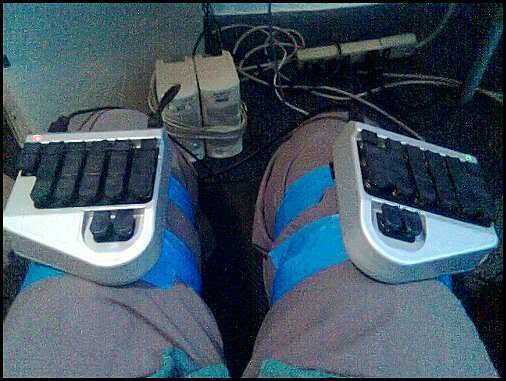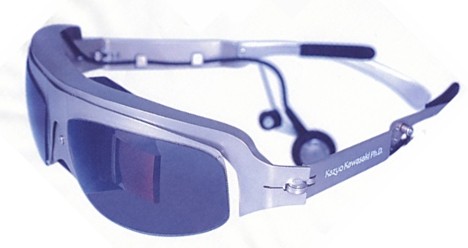This article was originally written for The
Plover Blog.
What is Steno Good For?
Part
One: How to Speak With Your Fingers
Part
Two: Writing and Coding
Part
Three: The Ergonomic Argument
Part
Four: Mobile and Wearable Computing
Part
Five: Raw Speed
Part
Six: CART, Court, and Captioning
When I was 10 years old, my big brother William came to visit from
California. He was 29, had a mohawk and mirrored sunglasses, worked
as an electronic engineer for a tech company in Silicon Valley, and
lived in a drainage tunnel because he didn't believe in rent.
 My brother William, just after graduating from Cal
Poly
My brother William, just after graduating from Cal
Poly
He was, needless to say, the coolest human being on
the planet. One day he came to talk to my 6th grade class
about careers in computer science. He walked into the school
wearing a head mounted display that projected green glowing
lines of ASCII onto his eyeballs, controlled by a clunky beige
laptop strapped to his chest (this was 1991), with a numeric
keypad peripheral tied around his right leg, which he
controlled using a chording system he'd invented himself.
Actually, he'd built all of it himself, putting it together
out of spare parts on a whim, and the instant I saw it, I
wanted one just like it. It was my first exposure to the idea
of writing via chording and my first taste of the dorktastic
awesomeness that is wearable
computing.
It shouldn't be too surprising that my brother abandoned his wearable
rig shortly after he got it all working. It was too heavy and too
hot, the display gave him eye strain, and the chording thigh pad was
hopelessly slow and uncomfortable.
 Not my brother. A guy named Steve
Mann.
Not my brother. A guy named Steve
Mann.
I've railed often enough against the inefficiencies of qwerty and its
tedious one letter per keystroke input ratio, but the one letter per
chord ratio of nearly all one-handed keypad systems ( Twiddler, Frogpad, Chordite, et al.) is even
slower, less accurate, and less ergonomic. The jacked-in cyberfuture
of the '90s failed to materialize, and while computers continued to
get faster and smaller, they remained external objects, migrating from
our desks to our backpacks to our pockets, but refusing to become part
of our wardrobes.
Fast forward 19 years. I'm now the age my brother was when he blew my
mind by walking into Washington Middle School like an awesome
apocalyptic cyborg. Every day I carry a 26-pound bag from my
apartment in Upper Manhattan to the subway and settle in for an hour
long commute to my office in downtown Brooklyn.
 This is actually an old picture. I've gotten a new steno
machine and a new laptop since then, and I don't carry the
wireless router anymore, since I now use Bluetooth instead.
But you get the general idea.
This is actually an old picture. I've gotten a new steno
machine and a new laptop since then, and I don't carry the
wireless router anymore, since I now use Bluetooth instead.
But you get the general idea.
The bag contains one laptop (a Lenovo SL400) and one tablet PC (a
Samsung Q1), both running Windows XP; two tripods; a Revolution Grand
steno machine; a USB foot pedal for audio transcription; and a bunch
of wires and cables. Sometimes I want to get my transcription work
done on the train during my commute, so I set up the steno machine on
its tripod, press the Samsung Q1 onto its heavy-duty velcro holder,
plug in the USB foot pedal and my Sennheiser HD 280 Pro headphones,
and start writing. It sounds less awkward than it is. When the train
is crowded, that maneuver is all but impossible, and I'm forced to
leave all my fancy transcription gear in my bag. Instead, I reach for
my phone. I can't do transcription work on it, but it keeps me
entertained.
Part three of What is Steno
Good For? was composed entirely on my phone (a Blackberry Curve 8330)
with two thumbs and a lot of patience. This is what mobile computing
means in 2010: Hunting and pecking on a teeny-tiny qwerty keyboard at
20 WPM. Oh, my 10-year-old cyberpunk self would be weeping. But why
are these pocket-sized systems currently the most convenient form of
mobile text input? Is this as good as it's going to get? Will we be
stuck tip-tapping on our phones with our thumbs forever? I sure hope
not. The basic problem is this: If it's small enough to fit in a
pocket, it's too small to type on efficiently. If it's too big to fit
in a pocket, it's too inaccessible to be available on the spur of the
moment. There are two potential solutions to the problem. One,
clothing-integrated or clothing-mounted text input. Two, virtual
space text input. The first one is easy enough to visualize. The
second one is pretty far out there, so I won't be addressing it at any
length, especially since I'm concerned that its usefulness will be
limited without at least a minimal amount of haptic feedback.
As you've probably guessed, this is the least reality-based article in
the What
is Steno Good For? series. None of my ideas for wearable
steno systems are anywhere close to currently available. My scheme is
to get people hooked on free software, free
steno training, and $60 steno machines first. Then maybe
once there's a critical mass of steno-savvy consumers, some company
will recognize the demand for efficient mobile computing and
manufacture the wearable computing technology I've always dreamed of.
My first job is to convince you that steno is actually an ideal
solution to the finger size versus pocket size paradox I referred to
before. But first, a quick detour on the subject of head-mounted
displays. It's a problem that still hasn't been solved to
anyone's satisfaction, even after several decades of trying. They're
too heavy, too fragile, too stupid-looking, too headache-inducing.
But let's posit that someday soon the problem will be solved, and
we'll be able to go out and buy lightweight, stylish augmented
reality overlay monitors that look just like ordinary
pairs of eyeglasses.
So you're walking down the street wearing your AR specs, watching text
hover gracefully over all of the local landmarks. What if you want to
interact with that text? What if you want to work on your novel while
doing your grocery shopping? Text chat with your friend in Belize
while walking your dog? Or, you know, write a blog post on a crowded
subway? If you're reading this on a desktop computer, put your qwerty
keyboard in your lap. If you're not, pretend. Imagine the keyboard
split in half and made flexible, melding with the fabric of your jeans
and wrapping around each leg. Then imagine trying to type on it while
walking. Do you see how many buttons that is? Even if you leave out
some of the metakeys, you've got 33 keys plus enter, shift, and space.
Make them big enough to fit your fingers, and they wrap clean around
to the back of your thigh. Make them small enough to fit completely
in the region where your fingers rest naturally, and it's impossible
to type on them accurately. The human hand, the human leg, and the
English alphabet seem to have irreconcilable differences.
 Yeah, no.
Yeah, no.
 See? Just... No.
See? Just... No.
But instead of 36 tiny little squares, what about two panels of ten
nested rectangles, plus two more resting under each thumb? Compared
to the qwerty layout it's both narrower and shorter, and those 24
panels (22 letters plus two asterisks) can be used to produce every
letter of the alphabet plus punctuation, commands, and special
characters to boot. At 260 words per minute, I might add -- but this
article isn't about speed; I'll get to that in the next one. This is
about walking and writing or sitting and writing or lying down and
writing or doing the cha-cha or riding bumper cars or running a
marathon and writing. Unlike on the qwerty keyboard, where you're
constantly moving your hands up or down, left or right, leaving and
returning to the home row, in steno the only fingers that ever leave
their fixed positions are the right pointer for the asterisk and the
right pinky for the D and Z keys. All the others stay put, making
touch typing much easier, even under bumpy conditions.
 Okay, this is really not doing it justice, but I don't
have Photoshop, so it's the best you're gonna
get.
Okay, this is really not doing it justice, but I don't
have Photoshop, so it's the best you're gonna
get.
Don't want to type on the tops of your thighs? Wear a hoodie and type
on your abs with your hands in the pockets. Cross your arms and type
on your biceps. The limited surface area required by the steno layout
means that you could hypothetically write in steno more or less
anywhere you can rest your fingers. Now, because it's a two-handed
system it's still going to be inconvenient in some situations, but
it's got a good shot at succeeding where the qwerty keyboard was
inevitably doomed to fail.
I know this clothing-integrated stuff is still many years away, but
even on the slightly less mobile front, I'm excited about the dual
screen multi-touch
laptops I've posted about recently. Putting steno on
those seems like a good compromise between my bulky three-part
transcription system and all these full-on wearable pipe dreams, and I
know they'd be a big help to me in my daily commute. We take our
technology with us almost everywhere we go these days, and we
desperately need a more elegant way of interacting with it. I think
steno could fit the bill.
 
PS: Just for laughs, here's my current most successful
attempt at mobile steno computing. It is not a practical
everyday solution. I use it to CART meetings and other events
with Deaf or hard of hearing clients who need to walk around a
lot; it worked quite well for a meet-and-greet tour of a
client's potential grad department, for instance. But this
sort of thing is way too bulky and weird-looking for anything
but special occasions. It uses my Samsung Q1, my Revolution
Grand, some gaffer's tape, and a Connect-a-Desk.
Far from perfect, but all I've got for now.
|
|













































|



























































































